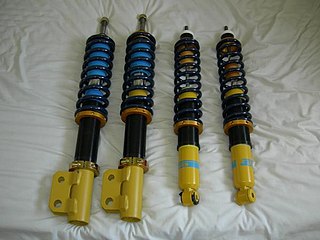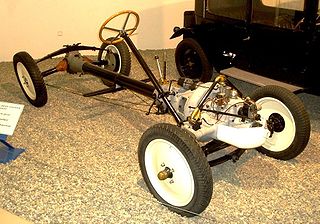
The MacPherson strut is a type of automotive suspension system that uses the top of a telescopic damper as the upper steering pivot. It is widely used in the front suspension of modern vehicles. The name comes from American automotive engineer Earle S. MacPherson, who invented and developed the design.

A strut is a structural component commonly found in engineering, aeronautics, architecture and anatomy. Struts generally work by resisting longitudinal compression, but they may also serve in tension.

Suspension is the system of tires, tire air, springs, shock absorbers and linkages that connects a vehicle to its wheels and allows relative motion between the two. Suspension systems must support both road holding/handling and ride quality, which are at odds with each other. The tuning of suspensions involves finding the right compromise. It is important for the suspension to keep the road wheel in contact with the road surface as much as possible, because all the road or ground forces acting on the vehicle do so through the contact patches of the tires. The suspension also protects the vehicle itself and any cargo or luggage from damage and wear. The design of front and rear suspension of a car may be different.

In architecture and structural engineering, a space frame or space structure is a rigid, lightweight, truss-like structure constructed from interlocking struts in a geometric pattern. Space frames can be used to span large areas with few interior supports. Like the truss, a space frame is strong because of the inherent rigidity of the triangle; flexing loads are transmitted as tension and compression loads along the length of each strut.

Independent suspension is any automobile suspension system that allows each wheel on the same axle to move vertically independently of the others. This is contrasted with a beam axle or deDion axle system in which the wheels are linked. "Independent" refers to the motion or path of movement of the wheels or suspension. It is common for the left and right sides of the suspension to be connected with anti-roll bars or other such mechanisms. The anti-roll bar ties the left and right suspension spring rates together but does not tie their motion together.

A double wishbone suspension is an independent suspension design for automobiles using two wishbone-shaped arms to locate the wheel. Each wishbone or arm has two mounting points to the chassis and one joint at the knuckle. The shock absorber and coil spring mount to the wishbones to control vertical movement. Double wishbone designs allow the engineer to carefully control the motion of the wheel throughout suspension travel, controlling such parameters as camber angle, caster angle, toe pattern, roll center height, scrub radius, scuff, and more.

The Chapman strut is a design of independent rear suspension used for light cars, particularly sports and racing cars. It takes its name from, and is best known for its use by, Colin Chapman of Lotus.

A coilover is an automobile suspension device. The name coilover is an abbreviation of "coil over shock absorber".

An anti-roll bar is an automobile suspension part that helps reduce the body roll of a vehicle during fast cornering or over road irregularities. It links opposite front or rear wheels to a torsion spring using short lever arms for anchors. This increases the suspension's roll stiffness—its resistance to roll in turns.

In automotive suspension, a control arm, also known as an A-arm, is a hinged suspension link between the chassis and the suspension upright or hub that carries the wheel. In simple terms, it governs a wheel's vertical travel, allowing it to move up or down when driving over bumps, into potholes, or otherwise reacting to the irregularities of a road surface. Most control arms form the lower link of a suspension. Control arms play a crucial role in the suspension system of a vehicle. They help to keep the wheels aligned and maintain proper tire contact with the road, which is essential for safety and stability.
The term structural system or structural frame in structural engineering refers to the load-resisting sub-system of a building or object. The structural system transfers loads through interconnected elements or members.

A lower tie bar is an alloy/steel bar that ties the lower suspension pick-up points of a vehicle together. It increases chassis rigidity by bracing the left and right lower-control-arm sheet metal mounting points. The lower tie bar is designed to reduce the non-pivoting movement of the control arms and to stiffen the subframe to lessen the distortion of the lower suspension, especially during hard cornering. As a result, it improves the handling and steering response of the vehicle. It may also provide additional benefits in front-wheel drive vehicles by reducing wheel hop and torque steer. The bar may lower ground clearance by as much as 30 millimeters on some aftermarket installations.

In an automobile, ball joints are spherical bearings that connect the control arms to the steering knuckles, and are used on virtually every automobile made. They bionically resemble the ball-and-socket joints found in most tetrapod animals.
A Corvette leaf spring is a type of independent suspension that utilizes a fiber-reinforced plastic (FRP) mono-leaf spring instead of more conventional coil springs. It is named after the Chevrolet Corvette, the American sports car for which it was originally developed and first utilized. A notable characteristic of this suspension configuration is the mounting of the mono-leaf spring such that it can serve as both ride spring and anti-roll spring. In contrast to many applications of leaf springs in automotive suspension designs, this type does not use the spring as a locating link. While this suspension type is most notably associated with several generations of the Chevrolet Corvette the design has been used in other production General Motors cars, as well as vehicles from Volvo Cars and Mercedes-Benz Sprinter van. Fiat produced cars with a similar configuration, using a multi-leaf steel spring in place of the FRP mono-leaf spring.

The Bowin P3 is a monocoque racing car that was produced in 1968 by Bowin. The P3 was designed for the Australian National Formula and the Australian 1½ Litre Formula. After the capacity limit for Australian Formula 2 was increased from 1100cc to 1600cc at the beginning of 1969, the P3 found a new home in that class. The car was designed by John Joyce, founder of Bowin and assisted by Ray Parson, better known as a mechanic.
This is an alphabetical list of articles pertaining specifically to structural engineering. For a broad overview of engineering, please see List of engineering topics. For biographies please see List of engineers.

Backbone tube chassis is a type of automobile construction chassis that is similar to the body-on-frame design. Instead of a two-dimensional ladder-type structure, it consists of a strong tubular backbone that connects the front and rear suspension attachment areas. A body is then placed on this structure. It was first used in the English Rover 8hp of 1904 and then the French Simplicia automobile in 1909.

A motorcycle frame is a motorcycle's core structure. It supports the engine, provides a location for the steering and rear suspension, and supports the rider and any passenger or luggage. Also attached to the frame are the fuel tank and battery. At the front of the frame is found the steering head tube that holds the pivoting front fork, while at the rear there is a pivot point for the swingarm suspension motion. Some motorcycles include the engine as a load-bearing stressed member; while some other bikes do not use a single frame, but instead have a front and a rear subframe attached to the engine.

A vehicle frame, also historically known as its chassis, is the main supporting structure of a motor vehicle to which all other components are attached, comparable to the skeleton of an organism.
Pull-rod suspension and push-rod suspension refer to a specialised type of automotive suspension system which is largely based on a double-wishbone system, incorporating elements of the commonly used MacPherson strut.



















